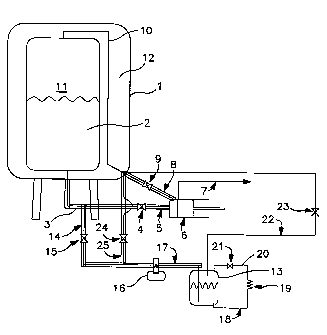Some of the information on this Web page has been provided by external sources. The Government of Canada is not responsible for the accuracy, reliability or currency of the information supplied by external sources. Users wishing to rely upon this information should consult directly with the source of the information. Content provided by external sources is not subject to official languages, privacy and accessibility requirements.
Any discrepancies in the text and image of the Claims and Abstract are due to differing posting times. Text of the Claims and Abstract are posted:
| (12) Patent: | (11) CA 2614195 |
|---|---|
| (54) English Title: | CRYOGENIC TANK SYSTEM |
| (54) French Title: | SYSTEME DE RESERVOIR CRYOGENIQUE |
| Status: | Expired and beyond the Period of Reversal |
| (51) International Patent Classification (IPC): |
|
|---|---|
| (72) Inventors : |
|
| (73) Owners : |
|
| (71) Applicants : |
|
| (74) Agent: | MARKS & CLERK |
| (74) Associate agent: | |
| (45) Issued: | 2011-11-22 |
| (86) PCT Filing Date: | 2006-06-30 |
| (87) Open to Public Inspection: | 2007-01-18 |
| Examination requested: | 2008-01-03 |
| Availability of licence: | N/A |
| Dedicated to the Public: | N/A |
| (25) Language of filing: | English |
| Patent Cooperation Treaty (PCT): | Yes |
|---|---|
| (86) PCT Filing Number: | PCT/US2006/025552 |
| (87) International Publication Number: | WO 2007008453 |
| (85) National Entry: | 2008-01-03 |
| (30) Application Priority Data: | ||||||
|---|---|---|---|---|---|---|
|
A cryogenic tank system wherein cryogenic liquid from a primary cryogenic
liquid storage tank (1) is subcooled by refrigeration generated by a
cryocooler (16), passed into an auxiliary tank (13), pressurized, and returned
to the primary storage tank (1), preferably by way of the cryocooler (16),
thus cooling the storage tank (1) contents and reducing the pressure within
and the vapor losses from the storage tank (1).
L'invention concerne un système de réservoir cryogénique dans lequel un liquide cryogénique provenant d'une cuve de stockage primaire de liquide cryogénique (1) est sous-refroidi par du froid généré par un cryoréfrigérateur (16), est transféré dans une cuve auxiliaire (13), est mis sous pression et est renvoyé dans la cuve de stockage primaire (1), en passant de préférence par le cryoréfrigérateur (16), refroidissant ainsi le contenu de la cuve de stockage (1) et réduisant la pression à l'intérieur de la cuve de stockage (1) et les pertes de vapeur dans cette dernière.
Note: Claims are shown in the official language in which they were submitted.
Note: Descriptions are shown in the official language in which they were submitted.

2024-08-01:As part of the Next Generation Patents (NGP) transition, the Canadian Patents Database (CPD) now contains a more detailed Event History, which replicates the Event Log of our new back-office solution.
Please note that "Inactive:" events refers to events no longer in use in our new back-office solution.
For a clearer understanding of the status of the application/patent presented on this page, the site Disclaimer , as well as the definitions for Patent , Event History , Maintenance Fee and Payment History should be consulted.
| Description | Date |
|---|---|
| Time Limit for Reversal Expired | 2014-07-02 |
| Letter Sent | 2013-07-02 |
| Grant by Issuance | 2011-11-22 |
| Inactive: Cover page published | 2011-11-21 |
| Inactive: Final fee received | 2011-09-02 |
| Pre-grant | 2011-09-02 |
| Notice of Allowance is Issued | 2011-03-15 |
| Letter Sent | 2011-03-15 |
| Notice of Allowance is Issued | 2011-03-15 |
| Inactive: Approved for allowance (AFA) | 2011-03-03 |
| Amendment Received - Voluntary Amendment | 2011-01-19 |
| Inactive: S.30(2) Rules - Examiner requisition | 2010-07-19 |
| Amendment Received - Voluntary Amendment | 2010-06-07 |
| Inactive: S.30(2) Rules - Examiner requisition | 2009-12-07 |
| Inactive: Cover page published | 2008-03-27 |
| Letter Sent | 2008-03-25 |
| Inactive: Acknowledgment of national entry - RFE | 2008-03-25 |
| Inactive: First IPC assigned | 2008-01-29 |
| Application Received - PCT | 2008-01-28 |
| National Entry Requirements Determined Compliant | 2008-01-03 |
| Request for Examination Requirements Determined Compliant | 2008-01-03 |
| All Requirements for Examination Determined Compliant | 2008-01-03 |
| Application Published (Open to Public Inspection) | 2007-01-18 |
There is no abandonment history.
The last payment was received on 2011-06-13
Note : If the full payment has not been received on or before the date indicated, a further fee may be required which may be one of the following
Please refer to the CIPO Patent Fees web page to see all current fee amounts.
| Fee Type | Anniversary Year | Due Date | Paid Date |
|---|---|---|---|
| Request for examination - standard | 2008-01-03 | ||
| MF (application, 2nd anniv.) - standard | 02 | 2008-06-30 | 2008-01-03 |
| Basic national fee - standard | 2008-01-03 | ||
| MF (application, 3rd anniv.) - standard | 03 | 2009-06-30 | 2009-06-10 |
| MF (application, 4th anniv.) - standard | 04 | 2010-06-30 | 2010-06-21 |
| MF (application, 5th anniv.) - standard | 05 | 2011-06-30 | 2011-06-13 |
| Final fee - standard | 2011-09-02 | ||
| MF (patent, 6th anniv.) - standard | 2012-07-03 | 2012-05-30 |
Note: Records showing the ownership history in alphabetical order.
| Current Owners on Record |
|---|
| PRAXAIR TECHNOLOGY, INC. |
| Past Owners on Record |
|---|
| BARRY ALAN MINBIOLE |
| JALAL HUNAIN ZIA |
| JOHN H. ROYAL |
| NANCY JEAN LYNCH |
| RICHARD JOHN JIBB |
| THURMAN GORDON |